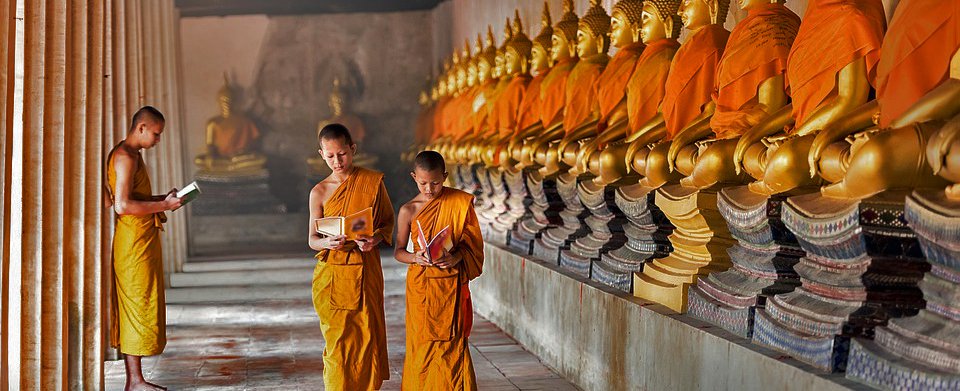

Laos
If you find it difficult to summarize your experiences upon leaving “The Jewel of Southeast Asia,” you’re probably not alone. Many discover that this charming country just offers that “special something” not so easily forgotten, and simultaneously fear that it will disappear if they don’t return soon enough. However, rest assured, change comes slowly to Laos and the genuine smiles of her people endure.
A must-see! This UNESCO World Heritage city is the most popular spot in all of Laos, yet it still manages to exude peace and tranquility from every colonial street corner. Set amongst a beautiful backdrop of verdant green, Luang Prabang is blessed with river views and wondrous temples, sidewalk cafes and colorful markets. It’s the perfect spot for bicycling! In town, our local hosts will show you Mount Phousy, the National Museum, a traditional Lao “royal opera,” and an early-morning monk processional (alms-giving included). Our hosts might even take you home to meet their own families. Outside of town, perhaps you’d like to visit an elephant camp or cruise the Mekong, tour a weaving co-op or sample some local rice wine. A little further out and the Pak Ou “Caves of a Thousand Buddhas” await.
Though it’s the center of commerce and administration within Laos, Vientiane lacks the hustle and bustle of other Southeast Asian capitals. Here, the pace is slow and the riverfront offers a variety of laid-back dining options. As in Luang Prabang, the French influence is still apparent; Vientiane’s central boulevard reminiscent of the Champs-Elysées, its colonial architecture blending with a Buddhist heritage. Depending on how long your capital stopover is, there are several notable temples, museums, and parks worth seeing.
One of the longest rivers in the world, originating north from China and the Tibetan Plateau, the mighty Mekong cuts a great distance through Laos before flowing onward through Cambodia and the Vietnam delta. Not surprisingly, the river is the lifeblood of this land, providing transport, trade, irrigation, fishing, and other opportunities for the people of Laos. Consider observing local river scenes via one of two charming boat journeys that we offer. The Luang Say cruise will take you from the Thai/Lao border town of Chiang Khong/Houei Say down to Luang Prabang, with an overnight stop at a Pakbeng eco-lodge and visists to ethnic villages (we also offer a private charter version of this route). The Vat Phou cruise will depart for several days from the southern city of Pakse, allowing you to visit pre-Angkorian ruins, the “4,000 Islands” of Laos, and the Pha Pheng waterfall on the Lao/Cambodian border, also known as the “Niagara of the East.”
If flying into Pakse in southern Laos, center of the great southern Lao kingdom of Champa, we’ll first head towards Champasak where you’ll stay a short distance north of Wat Phou, the oldest archeological site in Laos. Our favorite resort is in a quiet location along the banks of the mighty Mekong River. The pre-Angkorian ruins of Wat Phou, an exceptional UNESCO World Heritage Site, display early and classic Khmer architecture which dominated the region 1,000 years ago. This well-preserved (and now carefully maintained) landscape, including the namesake Wat Phou temple, was shaped to express the Hindu vision of the relationship between nature and humanity.
During your time in this area, we can also visit some of the “4,000 islands” of Laos like Don Khong and Don Khone, and also some local village stops and a local school where we can donate books and supplies. Near the Cambodian border, we’ll reach Khone Phapheng, considered to be the largest waterfall (by volume) in Southeast Asia, and also the widest. These falls are home to the endangered Irrawaddy River Dolphin.
There is a saying in Indochina: “The Vietnamese plant the rice, the Cambodians watch over the rice, and the Laotians listen to it grow.” Spend a bit of time anywhere in Laos, especially the countryside, and you will discover that this description quite aptly fits the slow pace and spiritual nature of the local people. Since Laos still has a long way to go before it becomes a major tourist destination, off-the-beaten-path adventures are common fare outside of the few main cities. For those with extended time to spare, highland treks in the north of the country allow visitors to pass through pristine wilderness and gain exposure to some hilltribe villages that have been around for centuries. There is also the option to head east of Luang Prabang in order to visit the Plain of Jars archeological site. Or south of Vientiane, down the less-frequented middle stretch of the Mekong (which forms the border with Thailand), there are interesting colonial towns such as Thakhek and Savannakhet. Laos shares its eastern border with Vietnam, formed mostly by the Annamite mountain chain. Finally, the Boloven Plateau, southeast of Pakse and north of Cambodia, is quite remote if you are looking for jungle hotels and elephant adventures.
Regions in Laos
"The world is a book, and those who do not travel read only a page."
St. Augustine